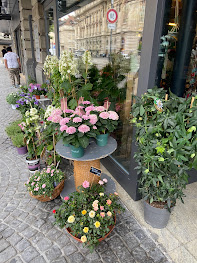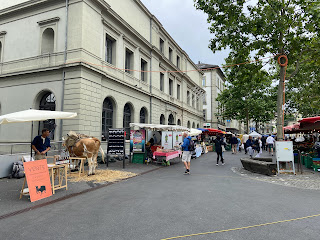Faster, Higher, Stronger - Together (or at least two out of three)
The morning of our only full day in Lausanne, we decided to again hit El Gato and couple this with a stop by Starbucks--which had been absent from our lives for almost two weeks at this point!
Wednesday mornings are market mornings in Lausanne's old town, which made the streets even more picturesque.
The food menu at this Starbucks included Birchermuesli, to my delight, and I learned that in Lausanne, I am "Yann." Coffee and gluten free croissants--yum!
Lausanne Cathedral anchors its old town and is built on one of the highest points, as the view from the road demonstrates. From this vantage point, you can also see how graffiti artists use the many levels of Lausanne to ladder their way to every surface.
Lausanne Cathedral was originally built in the 1200s and is recognized as one of Europe's most striking Gothic cathedrals. Over the last eight centuries, it has been redesigned and renovated, especially during the Reformation.
You can feel the weight and age of the cathedral. It is imposing and cold. You have to work and prove yourself to enter, literally: the door is so heavy that it requires both hands and good pull to open. The carvings surrounding the entrance are incredibly detailed and have been wonderfully maintained--each one is looking down on you in judgement.
The difference between the cathedrals we visited in Reykjavik and Lausanne captured the differences in the cities. Lausanne's was classically European, with a gorgeous stained glass window behind each arch and buttress.
The cathedral was testing and tuning its organ during our visit, which added to the atmosphere.
We also discovered a spirit haunting the cathedral; it appears to have come from a distant land but bore a passing resemblance to one of the carvings.
We took the spirit with us as we left Lausanne Cathedral and kept exploring.
What's been so interesting on this trip is how each of the Swiss cities we've visiting is so distinct. Lausanne felt older and had a different weight, and it was undeniably French--from its language to its nonchalantly cool attitude to its architecture to the little escargot on the stairs and the students studying in the Palais de Rumine bibliotheque.
The palace holds a university library and several small museums. We ducked inside to check it out. The building is lovely and all displays are in French; thanks to GoogleTranslate, we could navigate through. But recognizing that we were into the lunch hour, we stayed only a short time. Still very cool!
Like thousands of visitors before us, we left our stickers on the door as we departed.
On our way to lunch at an Indian restaurant nearby, we found another open air market (this one with a cow!) and a lovely vine.
One of Ned's favorite parts of any trip is using public transportation. Thus far, we had been on trains, funiculars, a boat, and a gondola--next up, the Lausanne metro, which we would be taking to Le Musee Olympique. At our stop, the sound of horses could be heard over the sound system. We didn't understand why until we walked past this sign for the Equestrian Federation.
The International Olympic Committee has called Lausanne home since 1918, and I've been watching the Olympics since 1968--for a half a century beginning a half century after the IOC moved to Lausanne. Coincidence? Doubt it.
Le Musee Olympique has a much shorter history--founded in the 1990s. When we planned Lausanne as one of our four stops in Switzerland, we did so because of Lake Geneva and our interest in doing German and French Switzerland. I didn't realize it was home to an Olympic museum. Score! By the way, I love that someone made a mistake and painted "Excellency" under Excellence on the mock-track into the museum parking lot and then made a lame attempt to cover it up. It's very Olympics: "yeah, we know we screw up, but let's be real--we're the only Olympics around, so get over it."
We actually walked in to the museum through the entrance to the restaurant entrance, which is called TOM. It may be an indication of my travel-addled brain that I wondered for some time, "Who is TOM? And why is he important to the Olympics?" And only realized after we got there that it stands for The Olympics Museum. Ah, day 13 of our trip, I'm feeling you.
The museum is surrounded by a sculpture garden that is--thematically--kind of all over the place (maybe a metaphor for the games themselves). You'll find bronze horse, athlete, and founder tribute sculptures, as expected, and then a statement about gun violence. Given the tragic murders of schoolchildren in Uvalde that occurred while we were in Iceland, this one made us pause.
To its credit, the museum, itself, while existing for the chief purpose of celebrating the Olympics and Olympic athletes, does not shy away from the violence that has sadly too often been the context for and happened at the games. And, Ned and I were shocked to learned that neither Harper or Penn were aware of the terrorist attack on the Munich 1972 Games. (This was one reason why Harper decided to watch every one of the short films available on each of the Games, which provide a snapshot of the social moment in addition to highlights of that Olympics.)
The museum opens with a look back at the very first Olympics in Greece. Perhaps my favorite We Take Ourselves flex occurred when Penn said, "I'm going to blow through this because we kind of actually saw this in real life." Given that, at his age, I could have only said that about a museum dedicated to the Wisconsin Dells or Disney World ('cause we lived 70 minutes away), it was a moment.
As we walked through the section of the museum praising Baron Pierre de Coubertin, we reflected on the craziness that over a century after an obsessed, wealthy guy had an idea and managed to leverage his connections and persistence to make it happen, we're still having Olympic Games. Even in celebrating the Baron, though, the museum lets you know that--at a number of points--the Games swerved away from some of his thoughts, like his deep and lasting conviction that women should not compete and--for reasons that are never clear--there should be no Winter Olympics. Perhaps alone in the exhibit, I was taken with the amazing wallpaper meant to signify the Baron's study (this is next level, TOM, well done!) and the shoddy sewing on the first ever Olympic banner, which--up close--really looks like kid's project.
In addition to the really well-done videos (the montage of opening ceremonies accompanied by fantastic sound in great headphones is really impressive and brought chills and tears to all of us), the museum shines a spotlight on the collateral of each games. The clear fashion winner: Mexico 1968. Check out these mod shifts that were made for and worn at the Games!
And, we learned that the outfits from the Opening Ceremonies, made to impress at a distance, can be absolutely striking and/or nutty when seen up close. In the first category, I give you Turin 2006, a diorama of the city and its home in the Italian Alps made into a dress for the host country's standard bearer. It's a 10!
The museum includes examples of the torches and medals from every Games. For reasons that were never explained, the Gold and Bronze medals are always the same in physical appearance; the Silver is most often different. My "half-assed internet research" didn't uncover the reason, either.
The museum ends with a fun, try it yourself, adventure section, for which Penn awarded himself the bronze--which looks just like the Gold, anyway.
We exited through the gift shop, picking up some t-shirts, two Swatches, some pins, and a Mexico 1968 magnet, and bid Le Musee Olympique adieu.
Turns out that we had missed the rain while inside, so the weather was good for a still storm-cloudy walk along Lake Geneva.
You can't fish here, but you can, apparently, walk right into the lake.
Our route to the Metro took us through the beautiful lakeside Ouchy part of Lausanne.
It started to rain lightly but steadily as we approached the station, which had an amazing ceiling--and a train that never left. Harper quickly mapped an alternate route on a city bus, adding another form of public transport to Ned's list!, and we learned that everything gets on the bus--people, strollers, bicycles, pets--and civility is alive and well: seats were offered readily to older passengers and moms.
We paused as the cafe around the corner for an afternoon cocktail and cappuccino break.
Our dinner that night was, appropriately, a Greek place a short, drizzly walk from the hotel, Le Lyrique. I had made reservations, and the server, who spoke French, was lovely, and was the only server in the place, moved a recently seated table when we arrived to give us a prime spot. Sign #1 we made a great choice! Sign #2, as we were ordering our drinks, a table next to us erupted into heated argument--in French--with table banging, stormings out and in, much French face-making, and an eventual reconciliation; our server apologized and we said no worries (so very French). Sign #3, there was a huge black dog in the back who just hung out calmly for hours. Sign #4, everyone in the place spoke French and seemed to know each other. Sign #5, people started showing up for dinner service around 9 pm. Sign #6, the food was fantastic! Le Lyrique, we loved you!
Checking out menu translations--thanks GoogleTranslate!
Again, don't try to drive in Lausanne people; it will get you nowhere!
We walked back up hill to the Hotel de la Paix for our last night, and the storm clouds gave way to a perfectly beautiful sunset.
As my boys knew, there was just one more city on the horizon in this amazing two week voyage uncroyable! The new(er) motto of the Olympics is "Faster, Higher, Stronger--Together." We may not have gone faster, but we definitely went higher and got stronger climbing our way through Lausanne, together :)























































































Comments
Post a Comment